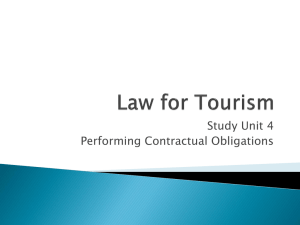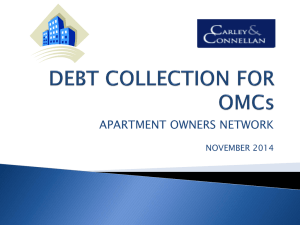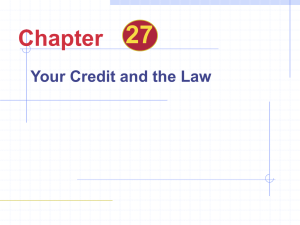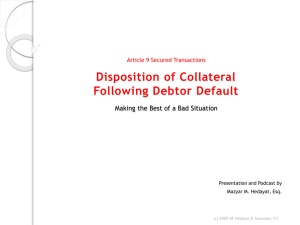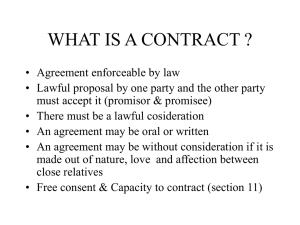PowerPoint-presentatie
advertisement
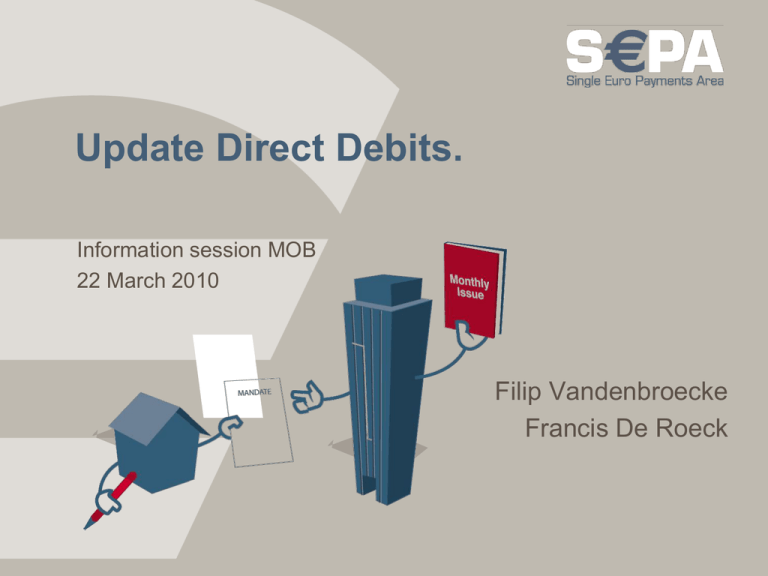
Update Direct Debits.
Information session MOB
22 March 2010
Filip Vandenbroecke
Francis De Roeck
Agenda
1.
Core scheme
2.
Continuity/migration of DOM80 mandates for SDD
3.
B2B scheme
4.
Questions ?
Appendixes
5.
Possible future developments
Information session Febelfin - 11/5/2009
2
1. SDD Core scheme :
Comparison with DOM 80(Post 1/4/2010)
Use
Creditor ID
Format
Mandate
Storage of the
mandate
Mandate reference
Type of DD
Pre-notification
cut-off times
Unpaids
Refunds
DOM 80- PSD
compliant
local
given by the NBB
CIRI
yes
Debtor Bank
Creditor ( DOM 70)
given by the Debtor
bank
recurrents
yes
D-1
D+3
8 weeks
13 months
SEPA Direct Debits
local & cross-border
given by the Creditor bank
XML format
yes
Creditor
given by the creditor
one-off’s and recurrents
yes
D-5 / D-2
D+5
8 weeks (authorised trx)
13 months (unauthorised)
Information session Febelfin - 11/5/2009
3
1. Core scheme :
Consequences for the Debtor
• Mandate managed by the Creditor
• The debtor will send his mandate to the creditor (and not to his bank)
• The debtor bank can offer specific services to the debtor (visualization of
mandates, controls…)
• Transparency
• The debtor is well informed by the creditor about the collection
• Good information about the product, rights, … from his bank
• Good protection
• Easy process for refund
• Belgian end European invoices
• Recurrent and one-off invoices
Information session Febelfin - 11/5/2009
4
1. Core scheme :
Consequences for the Creditor
• Mandate managed by the creditor
• The debtor will send his mandate to the creditor
• The creditor is responsible for dematerialisation & archiving
• New process and timelines
• New roles & responsibilities
• New contracts
• Same refund period as for DOM80(post PSD).
• New formats between the customer and the bank :
• IBAN/BIC
• XML Standard for Collections & Reversals (will be published in April)
• Full automated processing :
• End-to-end carrying of customer remittance data with a unique reference
• Ability to automate exceptions handlings like rejects, refunds, …
• Ultimate debtor and creditor
• Belgian and European invoices
• Recurrent and one-off collections
• Later extension to : E-signature & Business-to-Business
Information session Febelfin - 11/5/2009
5
1. Core scheme :
first experiences
• Some creditors started
• Only with new mandates
• No major issue
• new elements for Belgian Creditors
• Mandate management
• XML formats
• Limited volumes so far
• As from 1/4/2010 : possibility to issue SDD(core) collections based on
‘migrated’ DOM80 mandates.
• Migration to Isabel 6.
Information session Febelfin - 11/5/2009
6
2. Migration of 'old' BE mandates
Debtor
Debtor
bank
By Nov 1st, 2009
monthly upload
individual
notification of
enriched mandates
data
Active mandates + BIC + IBAN
download request
data of Creditor X
Creditor
bank
Creditor X
request for migration
Information session Febelfin - 11/5/2009
7
Direct Debits
Migration of existing Belgian mandates
• Belgian banks decided to limit the impact (for creditors &
debtors) by enabling the continuity of the 30 millions existing
mandates
• Procedure :
–
–
–
–
–
Debtor Bank will upload to the NBB the electronic datas about the
DOM80 mandates of their customers (debtors) with IBAN/BIC
The NBB will store all mandate information in a central database
The Creditor can ask to his bank a file will all mandates in his
favor
The Creditor Bank will then ask the download to the NBB which
will send the file to the Creditor
Debtor Banks have to keep the archived mandates
• Mandates migrated are only Core scheme mandates, for B2B
mandates, a new signature is needed
Information session Febelfin - 11/5/2009
8
3. B2B (Business to Business) scheme
• Major differences versus the core scheme:
- Specific mandate.
- No refund
- Eligible debtors :
- only ‘business’.
- Concrete criteria left to debtor banks
- Confirmation of consent by debtor to his bank required.
- Shorter timelines
- D-1 for presentations
- D+2 for returns
– No Migration of DOM80 mandates into B2B mandates.
– Only new mandates
- The B2B scheme is optional for Banks
- (for the Core scheme, each bank must participate as debtor bank).
- but 12 banks are already operational in Belgium
Information session Febelfin - 11/5/2009
9
10
3. B2B scheme :
first experiences
• Some creditors started
• Major attention points
• Too many collections returned due to lack of consent
available at the level of the debtor’s bank
– Ask your debtor to confirm to his bank about his consent (f.i.
copy of the mandate)
• Eligibility of debtors
– This can not be imposed to debtor banks (optional scheme).
Ask your debtor to contact his bank
Information session Febelfin - 11/5/2009
11
more info ?
Following information is available on the site www.Sepabelgium.be
• Rule books
–
Core & B2B
• Implementation guidelines
–
–
–
–
Core & B2B
bank to bank
Customer to bank (Unifi 20022)
Bank to Customer (CODA 2)
• Brochure SEPA DD (Febelfin)
• Migration of DOM80 mandates to core scheme mandates
–
–
Migration procedure for banks (debtor banks & creditor banks)
Migration contract for banks (debtor banks & creditor banks) (soon
available)
Information session Febelfin - 11/5/2009
12
Good to know : Average number of direct
debits per citizens (2006)
Information session Febelfin - 11/5/2009
13
Questions
?
?
?
Information session Febelfin - 11/5/2009
14
Update Direct Debits.
full version
Information session MOB
22 March 2010
Filip Vandenbroecke
Francis De Roeck
Agenda
0. PSD & impact on DOM80
1. Core scheme
2. Continuity/migration of DOM80 mandates for
SDD
3. B2B scheme
4. Questions ?
Appendixes
5. E-mandate
6. Possible future developments
Information session Febelfin - 11/5/2009
16
0. PSD versus SEPA
•Scope of PSD
– Covers all forms of electronic
payments, including:
• Cash to bank (deposits)
– Out of scope:
• Pure cash payments (cash to cash)
• Cheques, bills of exchange etc.
•Scope of SEPA
– Applies to limited number of
payments:
• credit transfers
• cards
• direct debits
– Geographic area is
• EU – 27 countries
• EEA – 3 countries
– Covers transactions in all EU
currencies – 15 currencies (incl.
EEA currencies)
– Bank to customer
– Law, hence: Mandatory
– Geographic area is EU 27 + EEA +
CH
– Covers only transactions in Euro!
– Interbank area
– Voluntary adherence
Information session Febelfin - 11/5/2009
17
0.Comparison DOM 80/ DOM 80 PSD compliant
DOM 80
Use
local
Creditor ID
given by the NBB
Format
CIRI
Mandate
yes
Storage of the
Debtor Bank
mandate
Creditor ( DOM 70)
Mandate reference
given by the Debtor
bank
Type of DD
recurrents
Pre-notification
yes (in practice ?)
cut-off times
D-1
Unpaids
D+4
Refunds
4 days
DOM 80- PSD compliant
idem
idem
idem
idem
idem
idem
idem
yes
idem
D+3
8 weeks (authorised tr)
13 months (Dom70)
(unauthorised)
Information session Febelfin - 11/5/2009
18
0. Impact of the PSD on DOM 80
1. Refund period needs to be integrated
•
- 8 weeks for authorised transactions: unconditional
refund (DOM 70/80)
•
- 13 months for unauthorised transactions (DOM 70)
2. Value date = Book date
3. New contract to be PSD compliant
4. The existing mandate forms can still be used but need to
give an explicit reference to the underlying contract
5. The pre-notification ( the debtor has to be advised before
the debit)
6. The execution time: D+3 (instead of D+4)
Application 01/04/2010
Information session Febelfin - 11/5/2009
19
1. SDD Core scheme :
Comparison with DOM 80(Post 1/4/2010)
Use
Creditor ID
Format
Mandate
Storage of the
mandate
Mandate reference
Type of DD
Pre-notification
cut-off times
Unpaids
Refunds
DOM 80- PSD
compliant
local
given by the NBB
CIRI
yes
Debtor Bank
Creditor ( DOM 70)
given by the Debtor
bank
recurrents
yes
D-1
D+3
8 weeks
13 months
SEPA Direct Debits
local & cross-border
given by the Creditor bank
XML format
yes
Creditor
given by the creditor
one-off’s and recurrents
yes
D-5 / D-2
D+5
8 weeks (authorised trx)
13 months (unauthorised)
Information session Febelfin - 11/5/2009
20
1. Core scheme :
Process for the mandate
The provider
The seller
The creditor
1. The customer buys a service
/ a good from the provider
The customer
The buyer
The debtor
3. If the debtor chooses
the European Direct Debit
as payment instrument,
he fills & signs the
mandate form
4. He sends it to the
creditor
2. The customer receives a contract / an invoice and
a mandate form from his provider
5. The creditor
updates his
administration and
archives the
mandate.
Contract / Invoice
Reference : 123456789
Provider’s name :
subscription Magazine ABC
Amount : 57,23 €
Payment by :
European Direct Debit
Mandate
SEPA Direct Debit Mandate
CREDITOR'S
NAME & LOGO
Mandate reference - to be completed by the creditor
By signing this mandate form, you authorise (A) {NAME OF CREDITOR} to send instructions to your bank to debit your
account and (B) your bank to debit your account in accordance with the instructions from {NAME OF CREDITOR}.
As part of your rights, you ar
Your name
+
*
1
Your name
Name of the debtor(s)
Name of the debtor(s)
Your address
*
Your address
2
Street name and number
Street name and number
*
3
Postal code
Postal code
City
City
*
4
Country
Country
Debtor identification code
5
Debtor identification code
Creditor's name
For business users: w rite any code number here w hich you w ish to have quoted by your bank.
For business users: write any code number here which you wish to have quoted by your bank.
**
Creditor's name
6
Creditor name
Creditor name
**
7
Creditor Identifier
Creditor Identifier
**
8
Sreet name and number
Street name and number
**
9
Postal code
Postal code
City
City
**
10
Country
Country
11
Creditor reference party: Creditor must complete this section if collecting payment on behalf of another party .
Creditor reference party: Creditor must complete this section if collecting payment on behalf of another party .
Your account number
*
Your account number
12
Account number - IBAN
Account number - IBAN
*
13
SWIFT BIC
Person on whose behalf
payment is made
14
Debtor Reference Party: If you are making a payment in respect of an arrangement betw een {NAME OF CREDITOR} and another
person (e.g. w here you are paying the other person's bill) please w rite the other person's name here.
If you are paying on your ow n behalf, leave blank.
Debtor Reference Party: If you are making a payment in respect of an arrangement between {NAME OF CREDITOR} and another
person (e.g. where you are paying the other person's bill) please write the other person's name here.
If you are paying on your own behalf, leave blank.
Person on whose behalf
payment is made
In respect of the contract
**
In respect of the contract:
15
Identification number of the underlying contract
Identification number of the underlying contract
**
16
Description of contract
Description of contract
Type of payment
*
Type of payment
City or town in which you are
signing
City or town in which you are
signing
Recurrent payment
Recurrent payment
or
or
One-off payment
One-off payment
17
Date *
Location
Location
D
D
M
M
Y
Y 18
Date
Signature(s)
Signatures
Please sign here
*
Information session Febelfin - 11/5/2009
21
1. Core scheme :
Process for the payment (1)
1. The provider sends to the
debtor a pre advice at least 14
days before the due date.
Pre-notification
The creditor can send the pre-notification
separately or can join it to a statement or
an invoice.
Mandate reference : 123456789
Name of the supplier : Subscription Magazine ABC
Amount : 57,23 euros
Payment date : every year 15th of January
First payment : 15th of January 2009
An overview or a plan for several
collections is also acceptable
The creditor & the debtor can agree about
another timing for the pre-notification
Information session Febelfin - 11/5/2009
22
1. Core scheme :
Process for the payment (2)
Creditor
Debtor
2. The creditor sends the
collections with the Mandate
Related Information (MRI) to his
bank
6. The creditor’s
account is credited
4. The debtor’s bank
debits the account of
the debtor
Debtor’s
bank
Creditor’s
bank
3. The creditor’s bank sends the
collections + MRI to the debtor’s bank
Clearing
Settlement
5. The debtor’s bank pays the creditor’s bank
Information session Febelfin - 11/5/2009
23
1. Core scheme :
Exception handling & The R messages (1)
Information session Febelfin - 11/5/2009
24
1. Core scheme :
Exception handling & The R messages
• Reject: is DD collection that is diverted from normal execution
prior to inter-bank settlement by the Creditor Bank, CSM or
Debtor Bank (invalid format, wrong IBAN, check digit, refusal
by the debtor, …)
• Refusal: is a claim initiated by the Debtor before settlement
for any reason, requesting the Debtor Bank not to pay a DD
collection (the Debtor bank will then generate a reject)
• Return: is DD collection that is diverted from normal
execution after inter-bank settlement and is initiated by the
Debtor Bank within 5 target days. (insufficient balance on the
account, …)
• Refund: is a claim by the Debtor for a reimbursement of an
already settled DD
Information session Febelfin - 11/5/2009
25
1. Core scheme :
Exception handling & The R messages
• Revocation: is requested by the Creditor to recall the
instruction for a DD collection prior to the acceptance by the
Creditor Bank.
• Request for cancellation: is requested by the Creditor Bank to
recall the instruction for a DD collection prior to acceptance
by the CSM
• Reversal: when the Creditor concludes that a DD collection
should not have been processed after the Clearing and
Settlement and reimburses the Debtor with the full amount of
the erroneous collection within 2 days after settlement.
Can be initiated by Creditor Bank for the same reasons.
Information session Febelfin - 11/5/2009
26
1. Core scheme :
Consequences for the Debtor
• Mandate managed by the Creditor
• The debtor will send his mandate to the creditor (and not to his bank)
• The debtor bank can offer specific services to the debtor (visualization of
mandates, controls…)
• Transparency
• The debtor is well informed by the creditor about the collection
• Good information about the product, rights, … from his bank
• Good protection
• Easy process for refund
• Belgian end European invoices
• Recurrent and one-off invoices
Information session Febelfin - 11/5/2009
27
1. Core scheme :
Consequences for the Creditor
• Mandate managed by the creditor
• The debtor will send his mandate to the creditor
• The creditor is responsible for dematerialisation & archiving
• New process and timelines
• New roles & responsibilities
• New contracts
• Same refund period as for DOM80(post PSD).
• New formats between the customer and the bank :
• IBAN/BIC
• XML Standard for Collections & Reversals (will be published in April)
• Full automated processing :
• End-to-end carrying of customer remittance data with a unique reference
• Ability to automate exceptions handlings like rejects, refunds, …
• Ultimate debtor and creditor
• Belgian and European invoices
• Recurrent and one-off collections
• Later extension to : E-signature & Business-to-Business
Information session Febelfin - 11/5/2009
28
Creditor Identifier in Belgium
1. When Creditor has an Enterprise nb:
–
–
8 17 : Enterprise number (10 pos.)
This ID remains the same, whatever bank is that delivers it
2. When Creditor has no Enterprise nb:
–
–
–
•
BE 98 001 0456810810
BE 98 ZZZ 300 D 000000008
8 10 : Creditor Bank Code (3 pos.) ING=300
11
: “D”
12 20: Sequential Number (9 pos.)
Remark: The dom80 IDs that begin with 4 or more zeros may not be
used
BE 98 001 0000012345
•
Creditor Bank obligations:
–
–
–
Issue the Creditor Identifier (AT-02)
Issue the unique sequential nb when no enterprise nb exists
Deliver Creditor Identification issuance certificates when requested
Information session Febelfin - 11/5/2009
29
Informing creditors of the reason of
an R-transaction via CODA (4)
The bank of the creditor
–
–
Maps the SDD reason codes received into CODA reason codes
Differentiates between 4 code groups
• CODA reason 1 : maps codes indicating technical problems
–
Codes MD02, MD03, AG02, RC01, AM05
• CODA reason 2 : maps codes indicating other/unknown reason
–
–
Codes AM04, MS03
CODA reason 3 : maps codes indicating explicit disagreement by the debtor
–
Codes MD01,MD06 and MS02
• CODA reason 4 :maps codes indicating account problems
–
Codes AC01, AC04,AC06, AG01,BE01,MD07, RR01,SL01
Information session Febelfin - 11/5/2009
30
Collection initiation files
• One set of signatures
• Each DD batch:
– Same due date
– Can not mix Sequence Type:
•
•
•
•
First
Recurrent
Final
One-off
(D-5)
(D-2)
(D-2)
(D-5)
– Can not mix core with B2B
– Can mix different timelines in same Seq Type
• Recurrent normal (D-2) with Bank Changed (D-5) = when Debtor
goes to another bank & decides to keep the same mandate
– Individual procuration check (for NL)
• Different batch in file when
– Different due date
– Different scheme (core vs B2B)
– Different sequence type
rule
Information session Febelfin - 11/5/2009
31
1. Core scheme :
first experiences
• Some creditors started
• Only with new mandates
• No major issue
• new elements for Belgian Creditors
• Mandate management
• XML formats
• Limited volumes so far
• As from 1/4/2010 : possibility to issue SDD(core) collections based on
‘migrated’ DOM80 mandates.
• Migration to Isabel 6.
Information session Febelfin - 11/5/2009
32
2. Migration of 'old' BE mandates
Debtor
Debtor
bank
By Nov 1st, 2009
monthly upload
individual
notification of
enriched mandates
data
Active mandates + BIC + IBAN
download request
data of Creditor X
Creditor
bank
Creditor X
request for migration
Information session Febelfin - 11/5/2009
33
Direct Debits
Migration of existing Belgian mandates
• Belgian banks decided to limit the impact (for creditors &
debtors) by enabling the continuity of the 30 millions existing
mandates
• Procedure :
–
–
–
–
–
Debtor Bank will upload to the NBB the electronic datas about the
DOM80 mandates of their customers (debtors) with IBAN/BIC
The NBB will store all mandate information in a central database
The Creditor can ask to his bank a file will all mandates in his
favor
The Creditor Bank will then ask the download to the NBB which
will send the file to the Creditor
Debtor Banks have to keep the archived mandates
• Mandates migrated are only Core scheme mandates, for B2B
mandates, a new signature is needed
Information session Febelfin - 11/5/2009
34
3. B2B (Business to Business) scheme
• Major differences versus the core scheme:
- Specific mandate.
- No refund
- Eligible debtors :
- only ‘business’.
- Concrete criteria left to debtor banks
- Confirmation of consent by debtor to his bank required.
- Shorter timelines
- D-1 for presentations
- D+2 for returns
– No Migration of DOM80 mandates into B2B mandates.
– Only new mandates
- The B2B scheme is optional for Banks
- (for the Core scheme, each bank must participate as debtor bank).
- but 12 banks are already operational in Belgium
Information session Febelfin - 11/5/2009
35
3. B2B : Process for the mandate
1. The customer and the provider
negotiate a commercial transaction
The customer
The buyer
The debtor
3. If the
debtor
chooses the
European
Direct Debit
as payment
instrument,
the mandate
form is to be
filled & signed
The provider
The seller
The creditor
4A. The debtor sends the filled
and signed mandate to the
creditor
5. The
creditor
updates his
administrat
ion and
archives
the
mandate.
2. The customer receives a contract / an
invoice and a mandate form from his provider
Additional step for B2B :
4B. The debtor informs his Bank
about the signed mandate
Debtor’s
bank
Contract / Invoice
Reference : 123456789
Provider’s name : subscription
Magazine ABC
Amount : 57,23 €
Payment by :
European Direct Debit
Mandate
SEPA Direct Debit Mandate
CREDITOR'S
NAME & LOGO
Mandate reference - to be completed by the creditor
By signing this mandate form, you authorise (A) {NAME OF CREDITOR} to send instructions to your bank to debit your
account and (B) your bank to debit your account in accordance with the instructions from {NAME OF CREDITOR}.
As part of your rights, you ar
Your name
+
*
1
Your name
Name of the debtor(s)
Name of the debtor(s)
Your address
*
Your address
2
Street name and number
Street name and number
*
3
Postal code
Postal code
City
City
*
4
Country
Country
Debtor identification code
5
Debtor identification code
Creditor's name
For business users: w rite any code number here w hich you w ish to have quoted by your bank.
For business users: write any code number here which you wish to have quoted by your bank.
**
Creditor's name
6
Creditor name
Creditor name
**
7
Creditor Identifier
Creditor Identifier
**
8
Sreet name and number
Street name and number
**
9
Postal code
Postal code
City
City
**
10
Country
Country
11
Creditor reference party: Creditor must complete this section if collecting payment on behalf of another party .
Creditor reference party: Creditor must complete this section if collecting payment on behalf of another party .
Your account number
*
Your account number
12
Account number - IBAN
Account number - IBAN
*
13
SWIFT BIC
Person on whose behalf
payment is made
14
Debtor Reference Party: If you are making a payment in respect of an arrangement betw een {NAME OF CREDITOR} and another
person (e.g. w here you are paying the other person's bill) please w rite the other person's name here.
If you are paying on your ow n behalf, leave blank.
Debtor Reference Party: If you are making a payment in respect of an arrangement between {NAME OF CREDITOR} and another
person (e.g. where you are paying the other person's bill) please write the other person's name here.
If you are paying on your own behalf, leave blank.
Person on whose behalf
payment is made
In respect of the contract
**
In respect of the contract:
15
Identification number of the underlying contract
Identification number of the underlying contract
**
16
Description of contract
Description of contract
Type of payment
*
Type of payment
City or town in which you are
signing
City or town in which you are
signing
Recurrent payment
Recurrent payment
or
or
One-off payment
One-off payment
17
Date *
Location
Location
D
D
M
M
Y
Y 18
Date
Signature(s)
Signatures
Please sign here
*
Information session Febelfin - 11/5/2009
36
3. B2B : Process for the payment
Debtor
Creditor
1. The provider sends to
the debtor a pre advice at
least 14 days before the
due date.
2. The creditor sends the
collections with the Mandate
Related Information (MRI) to his
bank
6. The creditor’s
account is credited
4B. The debtor’s bank
debits the account of
the debtor
Debtor’s
bank
Creditor’s
bank
5. The debtor’s bank pays the creditor’s bank
Settlement
Additional step for
B2B : 4A. The debtor’s
bank checks the
agreement of the debtor
Clearing
3. The creditor’s bank sends the collections
+ MRI to the debtor’s bank
Information session Febelfin - 11/5/2009
37
3. Exception handling & The R
messages – B2B
Time line for the B2B scheme :
D-14
Creditor Presends
notification
Collection
to his bank
D-1
collection
sent
1) to CSM
2) to Deb bank
D
D+2
D+5
Limit to send Due date
collection
Settlement date
1) to CSM
Debit date
2) to Deb bank
Refusal (Debitor)
Return
reject
(Deb Bk)
Specific for B2B :
- Shorter timelines
- No Refund
Information session Febelfin - 11/5/2009
38
3. B2B scheme :
first experiences
• Some creditors started
• Major attention points
• Too many collections returned due to lack of consent
available at the level of the debtor’s bank
– Ask your debtor to confirm to his bank about his consent (f.i.
copy of the mandate)
• Eligibility of debtors
– This can not be imposed to debtor banks (optional scheme).
Ask your debtor to contact his bank
Information session Febelfin - 11/5/2009
39
more info ?
Following information is available on the site www.Sepabelgium.be
• Rule books
–
Core & B2B
• Implementation guidelines
–
–
–
–
Core & B2B
bank to bank
Customer to bank (Unifi 20022)
Bank to Customer (CODA 2)
• Brochure SEPA DD (Febelfin)
• Migration of DOM80 mandates to core scheme mandates
–
–
Migration procedure for banks (debtor banks & creditor banks)
Migration contract for banks (debtor banks & creditor banks) (soon
available)
Information session Febelfin - 11/5/2009
40
Good to know : Average number of direct
debits per citizens (2006)
Information session Febelfin - 11/5/2009
41
Questions
?
?
?
Information session Febelfin - 11/5/2009
42
4. In the pipeline :
E mandates : objectives
• Higher security : Validation by the debtor bank of :
• the correctness of the account and openness for SDD collections
• the access to the account based on the used identification mean.
less refunds for unauthorized collections.
• Paperless : Faster & easier process
• Fully automated E2E STP mandate processing
• One integrated process with the ordering / signing of the contract.
• The Debtor bank can store the MRI at that time
• Instead of based on the MRI sent with the first collection
• To improve its offering for visualisation / additional controls
• Dependencies :
• Documentation & standardisation (ISO)
• Offering of routing & validation services
• Facultative; no impact on the collections.
• Available for both schemes : core & B2B (later)
• No commitment yet on Belgian level. (analysis to be done)
Information session Febelfin - 11/5/2009
43
4. SDD e-Mandate
Service Description
Successive steps of the issuing process:
• Step 1: Debtor initiates e-Mandate on Creditor’s Web-Site;
checking by Creditor
• Step 2: Creditor submits e-Mandate proposal through routing service
• Step 3: to validation service of Debtor Bank
• Step 4: Debtor Bank invites Debtor to enter authentication means
• Step 5: Debtor Bank validates Debtor’s means of authentication and
confirms to Debtor
• Step 6: Debtor Bank confirms validation result through the original
routing service
• Step 7: to the Creditor
• Step 8: Creditor confirms final acceptance to Debtor and stores
e-Mandate
The collection is processed via the normal standard SDD procedure
Information session Febelfin - 11/5/2009
44
4. SDD e-Mandate
Diagram of the 4 party model
1.
Initiation
2 &3 Mandate request
Authorisation
4.
Confirmation
6 &7 E-Mandate
8
Confirmation
Information session Febelfin - 11/5/2009
45
5. Other possible developments
• Scheme ‘fixed amount’ – (no refund)
• Mandates via Zoomit
• MRI before first collection
Information session Febelfin - 11/5/2009
46
5.1. Other possible developments
scheme ‘fixed amount’ – no refund
• Major characteristics :
– Specific mandate : the mandate contains the amount of the
future collection(s).
– The debtor renounces explicitly his refund right
– The periodicity (f.i. one collection per month) is also an option in
this scheme
• Target
– No eligibility limitations at debtor side.
– Eligibility at creditor / business side not yet clear. There may be
a code of conduct reserving this scheme to the payment of goods
& services that by their nature cannot be returned.
– This scheme will be optional
• Status
– Status at EPC level : for validation in the Plenary of 24/3/2010.
– The Belgian banking community will support this scheme. The
timing is not yet discussed nor defined.
Information session Febelfin - 11/5/2009
47
5.2. Other possible developments :
mandates via Zoomit
• Major characteristics :
– Possibility for the creditor to submit mandates to the
debtor via zoomit
– Possibility for the debtor to sign the mandate electronically
– Possibility for the creditor to be sure that the mandate is
signed by the owner of the account or his representative
– Pure Belgian idea – no European solution
• Status
– Presented in last MOB; some positive reactions, but limited
interest expressed.
– To be analysed in the context of a joint action plan for the
migration
Information session Febelfin - 11/5/2009
48
5.2. Other possible developments :
Mandates via Zoomit.
IBAN
Dr bk 1
Connector
Connector
Sender
Mandate Requests
Dr Bk 2
Connector
Mandate Requests
Encrypted
URL to
DSP
Dr Bk 3
Connector
Send signed e-Mandate request
Sign eCheck
eAccount
X
Mandate
request
Document
Service Platform
DSP
Internet
Banking
Connector
Browser window 2
49
Mandates
Availability
Browser window 1
Information session Febelfin - 11/5/2009
49
5.3. Other possible developments :
MRI before first collection
• Major characteristics :
–
–
–
–
–
Possibility for the creditor to send the Mandate Related Information (MRI)
to the debtor bank as soon as the mandate has been signed by the debtor.
The debtor bank checks the eligibility : i.e. that the account number is
correct, open, and not blocked for Sepa Direct Debits.
Possibility for the debtor bank to inform the owner of the account about
this MRI; in this case : possibility for the debtor to react if required.
(for B2B : Possibility for the debtor bank to submit to the owner of the
account this MRI in order to get confirmation of his consent).
This Belgian idea has been submitted (once again) to the EPC :
• Support from major stakeholders (consummers; EACT)
• Limited support from major banking community.
• Status
–
–
–
Presented in last MOB; some positive reactions.
We monitor the development at European level : The belgian banking
community is not in favor of local flavours.
To be analysed in the context of a joint action plan for the migration
Information session Febelfin - 11/5/2009
50
5.3. MRI before first collection :
same first steps in the process for the mandate …
The provider
The seller
The creditor
1. The customer buys a service
/ a good from the provider
The customer
The buyer
The debtor
3. If the debtor chooses
the European Direct Debit
as payment instrument,
he fills & signs the
mandate form
4. He sends it to the
creditor
2. The customer receives a contract / an invoice and
a mandate form from his provider
Contract / Invoice
Reference : 123456789
Provider’s name :
Mandate
subscription Magazine ABC
Amount : 57,23 €
+
Payment by :
European Direct Debit
SEPA Direct Debit Mandate
5. The creditor
updates his
administration and
archives the
mandate.
CREDITOR'S
NAME & LOGO
Mandate reference - to be completed by the creditor
By signing this mandate form, you authorise (A) {NAME OF CREDITOR} to send instructions to your bank to debit your
account and (B) your bank to debit your account in accordance with the instructions from {NAME OF CREDITOR}.
As part of your rights, you ar
Your name
*
Your name
1
Name of the debtor(s)
Name of the debtor(s)
Your address
*
Your address
2
Street name and number
Street name and number
*
Postal code
Postal code
3
City
City
*
4
Country
Country
Debtor identification code
Debtor identification code
Creditor's name
5
For business users: w rite any code number here w hich you w ish to have quoted by your bank.
For business users: write any code number here which you wish to have quoted by your bank.
**
Creditor's name
6
Creditor name
Creditor name
**
7
Creditor Identifier
Creditor Identifier
**
8
Sreet name and number
Street name and number
**
9
Postal code
Postal code
City
City
**
10
Country
Country
11
Creditor reference party: Creditor must complete this section if collecting payment on behalf of another party .
Creditor reference party: Creditor must complete this section if collecting payment on behalf of another party .
Your account number
*
Your account number
12
Account number - IBAN
Account number - IBAN
*
13
SWIFT BIC
Person on whose behalf
payment is made
14
Debtor Reference Party: If you are making a payment in respect of an arrangement betw een {NAME OF CREDITOR} and another
person (e.g. w here you are paying the other person's bill) please w rite the other person's name here.
If you are paying on your ow n behalf, leave blank.
Debtor Reference Party: If you are making a payment in respect of an arrangement between {NAME OF CREDITOR} and another
person (e.g. where you are paying the other person's bill) please write the other person's name here.
If you are paying on your own behalf, leave blank.
Person on whose behalf
payment is made
In respect of the contract
**
In respect of the contract:
15
Identification number of the underlying contract
Identification number of the underlying contract
**
16
Description of contract
Description of contract
Type of payment
*
Type of payment
City or town in which you are
signing
City or town in which you are
signing
Recurrent payment
Recurrent payment
or
or
One-off payment
One-off payment
17
Date *
Location
Location
D
D
M
M
Y
Y 18
Date
Signature(s)
Signatures
Please sign here
*
Information session Febelfin - 11/5/2009
51
5.3. MRI before first collection :
additional steps before the first collection.
Creditor
Debtor
6. The creditor sends the
Mandate Related Information
(MRI) to his bank
11. The creditor
10. The debtor’s bank
can inform the debtor,
can propose additional
controls, etc.
Debtor’s
bank
receives the R
messages
Creditor’s
bank
9. The debtor’s bank sends a R message
if relevant
CSM
8. The debtor’s bank
checks that the account
is eligible (account valid;
open and not blocked
for SDD’s
7. The creditor’s bank sends the MRI
to the debtor’s bank
Information session Febelfin - 11/5/2009
52
